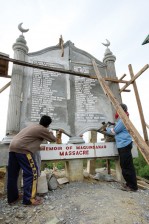Memorial rises on Maguindanao massacre site

MEMORIES THAT WILL NOT DIE Workers put finishing touches to a shrine where 58 Filipinos, most of them journalists, died in the infamous Maguindanao massacre. JEOFFREY MAITEM/INQUIRER MINDANAO
AMPATUAN, Maguindanao—On grassy slopes, concrete structures tower over the site of the massacre of 58 people here two years ago.
Spending nearly P13 million for the memorial, considered a permanent backdrop to the grisly carnage, Maguindanao designers say its essence rests on honoring the dead.
“This is a sacred place, a place for history to honor the dead,” said Jaypee Piang, chief of design, planning and programming division of Maguindanao’s provincial engineers office.
Graders are flattening the 3.2-kilometer rugged road leading to the site, while laborers are putting final touches to the structures in a race against time for the observance of the second anniversary of the massacre.
On Nov. 23, 2009, armed men gunned down and hacked to death 58 people in a convoy of supporters of gubernatorial aspirant Esmael Mangudadatu on their way to file his certificate of candidacy. The dead included 33 journalists covering the event.
Article continues after this advertisementMore than 100 people led by former Maguindanao Governor Andal Ampatuan Sr. are on trial for the massacre.
Article continues after this advertisementThe Maguindanao provincial board under Mangudadatu, who won as governor in 2010’s balloting, has appropriated P10 million for the concreting of a 1-km road; P2 million for a bare concrete and steel multipurpose hall, and two guardhouses; P150,000 for the concrete memorial marker; P480,000 for three solar-powered lamp posts, and P350,000 for the fence.
“The idea of building this kind of shrine is to inspire people to visit this place, that it’s safe to come here anytime, that there is nothing to fear about,” Piang said.
Several designs
Piang said several designs were drawn up for the memorial for Mangudadatu to approve. One design was an assembled-type steel but the road condition would not permit its construction.
“It can be assembled in the site but the absence of electricity would hamper its making. We would have to do welding works,” said the 24-year-old designer.
Mangudadatu had approved the design and ordered construction to begin in October for completion before November 23.
But the design has not gained wide approval.
Journalists who visited the site late October were displeased by the manner in which the grave sites were fenced.
“The place should not have been touched,” said Rowena Paraan, secretary general of National Union of Journalists of the Philippines, citing a number of pieces of evidence found in the site as the fence was being built.
About a meter-high fence with iron grills topped the grave sites in an effort to preserve and protect the area. In one grave, soldiers grew antipolo and talisay trees.
“They should not have touched the place. There were many pieces of evidence that can be found there,” she added.
58th victim
Rocky Sugadol, one of the guards at the site, said they found empty shells, slippers and a press card in the area.
The remains of 57 people were recovered immediately after the killings.
But the body of the 58th victim, Reynaldo “Bebot” Momay, photographer of Midland Review in Tacurong City, has not been recovered.
“Only if they dug deeper, they could have found my father,” said Reynafe Momay-Castillo, daughter of Reynaldo.
“The intention was to fence off the graves and leave them as is to preserve it and maintain its sanctity,” Piang said.
The memorial marker, which earlier bore erroneous spelling of names of victims and added unnamed students from Notre Dame University, has finally been etched out with the exact figure and spelling of victims’ names.